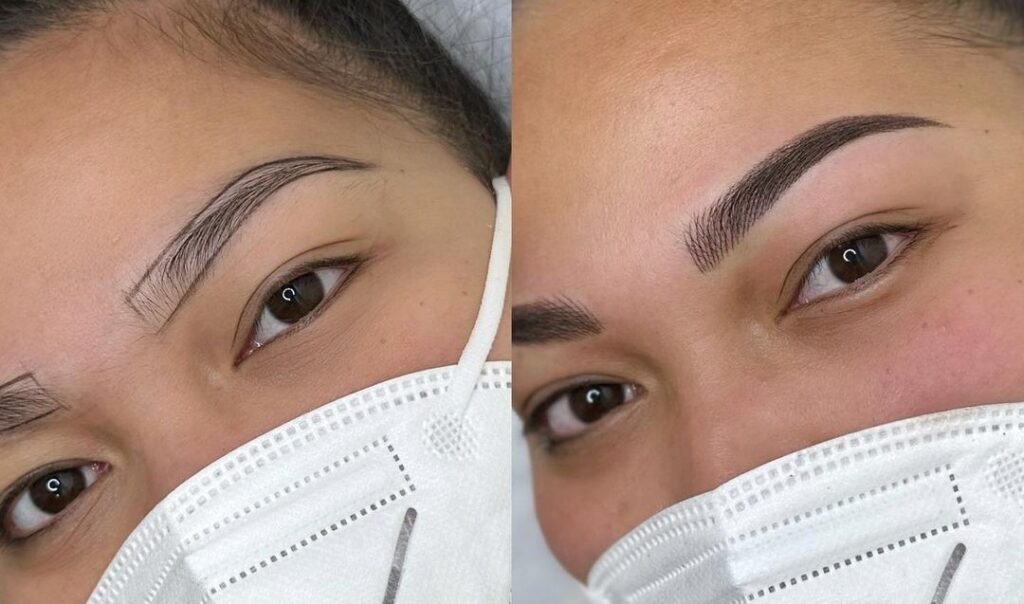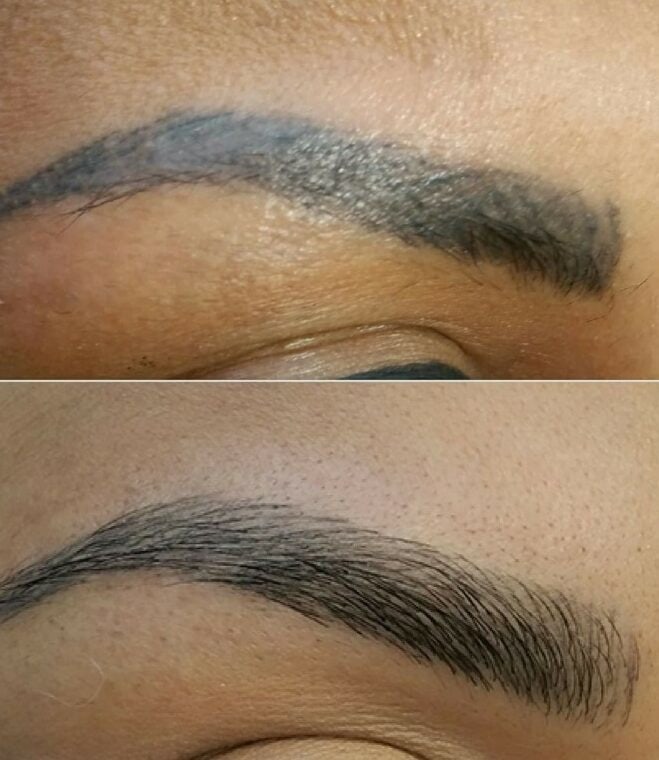
Author: expert Ella Pill
Instagram: @ella_permanentmakeup
21 years in the beauty industry. An expert in permanent makeup for Eyebrows, Lips, and Eyeliner.
In this article, we will cover common questions and concerns about Microblading eyebrows. We hope to provide you with the information you need to make an informed decision about microblading. Remember, it is important to consult with a qualified professional for the most beautiful and natural-looking results. Take advantage of microblading and unleash the potential of flawless eyebrows that bring out your natural beauty.

Microblading is a semi-permanent makeup technique used to achieve fuller, better-defined eyebrows. A skilled artist employs a compact, manual tool equipped with a row of ultra-fine needles to implant pigment just beneath the skin’s surface. This creates delicate, individual hair-stroke patterns that closely resemble natural eyebrow hairs, delivering a soft and realistic appearance.
Although it falls under the umbrella of cosmetic tattooing, microblading differs significantly from traditional machine tattooing. It targets only the uppermost layers of the skin (epidermis and very top of the dermis), rather than depositing pigment deeper into the dermis like classic tattoos. As a result, the color gradually fades over time due to natural skin cell turnover. With proper care, results typically last 1 to 3 years, after which most clients return for a refresh or touch-up session.
Permanent makeup (also called micropigmentation or cosmetic tattooing) is a procedure where pigment is implanted into the upper layers of the skin to create long-lasting enhancement of facial features – most often eyebrows, eyeliner, and lips.
It is not truly permanent in the same sense as a traditional tattoo. The pigment fades gradually over time because of natural skin cell turnover, exposure to sunlight, and other factors. Still, it is considered “permanent” since it cannot be washed off like regular makeup and typically lasts several years, with periodic touch-ups needed to refresh the color and sharpness.
A full microblading session usually lasts 2.5–3 hours for the first appointment. This time covers the initial consultation, precise brow mapping and design, numbing application, and the actual pigment implantation process (which itself takes roughly 1–2 hours).
The follow-up touch-up appointment is shorter, typically 1–2 hours, and is normally booked 4–6 weeks after the initial session to perfect the shape, add density where needed, and adjust color.
Healing timeline:
Results generally last 12–30 months (1–2.5 years) before a maintenance touch-up is recommended to refresh the strokes and vibrancy.
Yes, permanent makeup (cosmetic tattooing / micropigmentation) is generally safe when done by a qualified professional. However, as an invasive procedure, it carries some risks: infection, allergic reactions, scarring (including keloids), swelling, and in rare cases MRI-related issues.
Safety depends on choosing a licensed technician who uses sterile single-use needles, follows strict hygiene standards, and works in a clean environment. A patch test 24–48 hours before the procedure is strongly recommended to check for pigment allergies.
Proper aftercare is essential to avoid complications.
It’s not suitable for everyone – avoid it if you’re pregnant, have bleeding disorders, active skin conditions, keloid tendency, or a weakened immune system.
Microblading healing generally takes 4–8 weeks for complete skin regeneration and final color stabilization.
A touch-up appointment around 6–8 weeks after the initial session is essential to perfect the shape, fill in any sparse areas, and restore the desired color intensity and crispness.
Yes, the microblading touch-up session (usually scheduled 4-8 weeks after the initial procedure) is considered essential for optimal results. During this appointment, the artist corrects any patchiness, boosts areas where pigment didn’t retain evenly, refines the shape, and adjusts color intensity.
Without the touch-up, many clients end up with uneven, lighter, or incomplete brows-essentially leaving the procedure only partially finished. Skipping it often leads to disappointing, shorter-lasting results, while getting the touch-up transforms good initial work into crisp, symmetrical, and longer-lasting brows.
No, it’s generally not recommended to schedule your microblading touch-up sooner than 4 weeks. Most experienced artists advise waiting 4–8 weeks (and sometimes up to 6–10 weeks) so the skin can fully heal, excess pigment sheds naturally, and the true color retention becomes visible.
Getting a touch-up too early can:
Waiting the full recommended period allows the artist to accurately assess what needs adjustment and deliver the best, longest-lasting outcome without compromising skin health.
Yes, microblading typically causes mild to moderate discomfort rather than sharp pain. Most people describe the sensation as scratching, light stinging, or a tingling feeling during the procedure.
A high-quality topical numbing cream is applied beforehand (and often reapplied during the session), which significantly reduces discomfort for the majority of clients. As a result, microblading is generally much less painful than a traditional tattoo and feels similar to waxing, threading, or getting a Brazilian for many people.
Pain tolerance varies from person to person, and factors like individual sensitivity, the artist’s technique, and even your menstrual cycle phase can influence how it feels. However, with proper numbing, most clients find the experience quite manageable and tolerable.

In some cases, immediately after microblading, your eyebrows may appear bluish or grayish. This can be caused by oxidation of the pigment or by skin tones affecting the color. However, this discoloration usually disappears within a few days, acquiring the desired color. In addition, this problem can be due to the fact that, the microblading master hammered the pigment too deep into the skin.
Microblading results typically last 1–3 years, though the exact duration varies significantly depending on individual factors.
With diligent aftercare-such as strict sun protection (SPF daily), avoiding harsh actives in the brow area, and following all post-care instructions – the results can lean toward the longer end of the spectrum. Without proper maintenance, fading happens noticeably sooner.
Pre-Care (Before Your Appointment) To ensure the best results and minimize complications, follow these guidelines in the days/weeks leading up to your microblading session:
Post-Care (First 1–2 Weeks After) Proper aftercare is critical for good pigment retention, even healing, and preventing infection or scarring.
Microblading is not recommended for people with the following conditions or situations:
In these cases, the procedure carries higher risks of complications, poor healing, pigment issues, or safety concerns. Always consult both your microblading artist and a doctor if you have any medical conditions or take medications that could affect the procedure.
While microblading is generally safe when performed by a trained professional, potential risks and complications include:
These issues are most often linked to poor hygiene, inexperienced technicians, skipping patch tests, or neglecting aftercare. Working near the eyes also raises the stakes for severe swelling or vision-related concerns if complications arise.
Choosing a licensed artist who uses sterile, single-use tools, performs a patch test, and follows strict sanitation protocols dramatically reduces these risks. Any signs of infection (excessive redness, pus, fever, or intense pain) require immediate medical attention.
Most people can return to work the same day or the next day after microblading, since there is typically no significant downtime or recovery period that keeps you at home.
However, for the first 7–10 days, you must strictly follow aftercare instructions to protect healing and pigment retention:
Right after the procedure, expect:
These effects usually calm down within a day or two, with scabbing and flaking starting around days 3–7. As long as your job doesn’t involve the above restrictions (sweat, water exposure, or heavy physical activity), returning quickly is generally fine. If your work involves any of those factors, consider taking 1–2 extra days off or planning lighter duties during the initial healing phase.
After microblading, avoid the following activities for 1–2 weeks (or as directed by your artist) to protect the healing skin, prevent infection, scarring, and uneven pigment loss:
These restrictions help keep the micro-wounds clean and undisturbed, allowing the skin to heal properly and the pigment to settle evenly for the best long-term results.
Yes, microblading can be corrected or adjusted after the initial procedure if the results aren’t exactly what you wanted or if changes occur over time.
Common correction options include:
All corrections should be performed by a highly experienced, licensed permanent makeup artist or certified laser technician to minimize risks like scarring, uneven fading, or further color shifts. Timing matters—wait until the skin has fully healed (at least 8–12 weeks after the last session) before pursuing any correction.
No, you cannot wear makeup as usual immediately after microblading. You must avoid applying any makeup-especially powder, liquid, cream, or brow products-directly on or around the treated eyebrow area for 7–14 days.
This restriction helps prevent:
You can usually resume your normal makeup routine (including foundation, concealer, and brow products) once the scabs have naturally fallen off and the skin feels fully healed – typically around the 2-week mark. Always follow your specific artist’s aftercare guidelines, as healing timelines can vary slightly by individual and technique.
Microblading is performed using a manual handheld tool (also called a microblading pen, holder, or microblade pen) — not an electric tattoo machine.
The tool consists of:
The blades themselves are tiny, ultra-sharp, arranged in a row – most commonly U-shaped, curved, angled, or nano-style configurations (e.g., 7-pin, 9-pin, 12-pin, 14-pin, or single nano needles). These blades make very shallow cuts (only into the epidermis and upper dermis) to deposit pigment in fine, hair-like strokes that mimic natural brow hairs.
Additional supporting tools typically include:
The entire process relies on the artist’s hand control for creating realistic, individual strokes – that’s why it’s often described as “hand-drawn” or “feather touch” tattooing.
Microblading pigments are specially formulated colorants created for semi-permanent cosmetic tattooing. They are designed to implant safely into the upper layers of the skin and fade gradually over time, unlike deeper, more permanent traditional tattoo inks.
These pigments generally fall into two main categories:
Most high-quality microblading pigments are hybrid blends (combining organic and inorganic components) for the best balance of color intensity, longevity, and natural appearance. They are mixed with safe carriers such as glycerin, witch hazel, or alcohol to create a smooth, implantable consistency.
Reputable brands prioritize:
This careful formulation ensures the strokes look soft and realistic initially and continue to soften gracefully as they fade over 1–3 years, rather than remaining bold and unchanging like classic tattoo ink.
Yes, men do get microblading. It’s increasingly popular for filling sparse areas, correcting shape and adding natural-looking density. Many artists now specialize in masculine designs – straighter, thicker, less arched brows with subtle, realistic strokes that enhance without looking obvious.
Microblading and powder brows (also called ombre brows or powder fill) are both popular semi-permanent eyebrow techniques, but they differ in method, appearance, and best skin types.
To slow fading and extend the life of your microblading results (ideally keeping them looking crisp for 1–3 years), follow these key steps:
During the initial healing phase (first 1–2 weeks):
Long-term maintenance (ongoing):
Maintenance appointments:
Consistent sun protection and proper aftercare make the biggest difference – clients who follow these habits often enjoy noticeably longer-lasting, more even results.
Welcome to All Esthetics
10 Verbena Ave, Floral Park, NY 11001.
Sign up for Microshading, Microblading, Permanent Makeup Lips…
We welcome customers at our second office: 519 Central Ave, Massapequa, NY 11758. Prices at this office are different. For information on service prices, please call